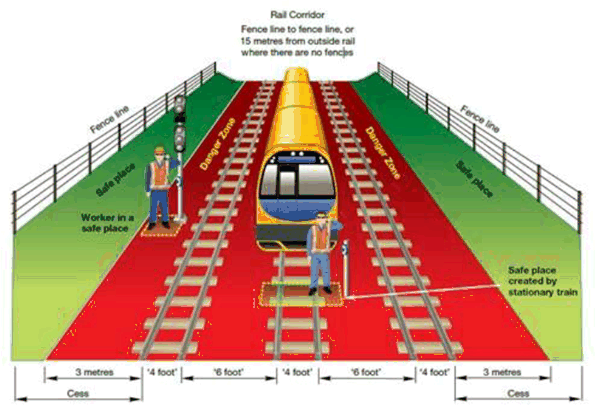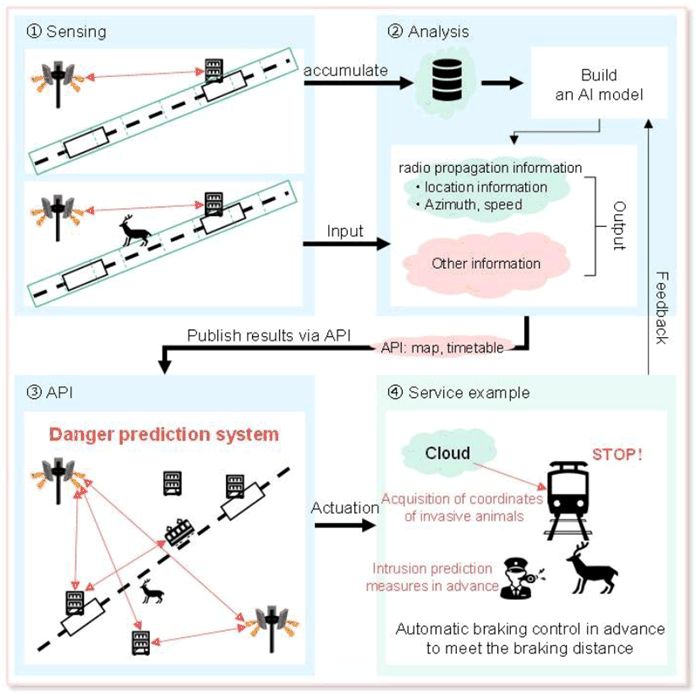Content for TR 22.837 Word version: 19.3.0
0…
4
5…
5.2…
5.3…
5.4…
5.5…
5.6…
5.7…
5.8…
5.9…
5.10…
5.11…
5.12…
5.13…
5.14…
5.15…
5.16…
5.17…
5.18…
5.19…
5.20…
5.21…
5.22…
5.23…
5.24…
5.25…
5.26…
5.27…
5.28…
5.29…
5.30…
5.31…
5.32…
6…
7…
5.7 Use case on sensing for railway intrusion detection
5.7.1 Description
5.7.2 Pre-conditions
5.7.3 Service Flows
5.7.4 Post-conditions
5.7.5 Existing feature partly or fully covering use case functionality
5.7.6 Potential New Requirements needed to support the use case
...
...
5.7 Use case on sensing for railway intrusion detection p. 27
5.7.1 Description p. 27
Extensive railway deployment and the changing wildlife habitat area due to the changing global environment has led to increase of crash of wildlife to trains. Once a crash happens, its recovery costs, takes time, and impairs convenience [18], [19]. Such a crash should be avoided, but it appears difficult to proactively predict wildlife's intrusion onto railway track. It's different from e.g., weather forecast. Passively detecting wildlife's intrusion onto railway track appears an option to take. Monitoring with cameras serves the same purpose. However, this requires LOS (i.e., line of sight) and a dense deployment of cameras, which is not necessarily efficient. Another traditional mechanism using fibre optic sensing techniques is costly and requires manual intervention, making it very difficult to meet the increasing demand for railway monitoring. Thanks to the 5G NR based sensing, the base station as transmitter and receiver along the railway can constantly sense the railway situation such as railway intrusion.
The assumption of this use case is the following:
- There is at least 300km train line as depicted in the Figure 5.7.1-1 [19] owned by railway operator. The safe place is a place where a person and their equipment cannot be struck by rail traffic, which is used for minimizing damage caused by possible railway accident or crash and for ensuring safe operation of railway. The danger zone is anywhere within 3m horizontally from the nearest track.
- The typical size and velocity of intruder and train in this use case are described in the Table 5.7.1-1.
| Size
(Length x Width x Height) |
Velocity | |
|---|---|---|
| Intruder | Pedestrian(Adult):
0.5m x 0.5m x 1.75m | 5km/h |
| Animal(Sheep/deer):
1.5m x 0.5m x 1 m | 5km/h | |
| Trains | 24m x 3.5m x 3 m | 100km/h - 350km/h |
When the intruder standing at the outermost side of safe place starts walking on the danger zone, it means the intrusion happens. The distance that intruder move perpendicular to the railway track is more sensitive for road safety, compared to the distance parallel to the railway track.

5.7.2 Pre-conditions p. 28
Base stations are deployed near and along a railway track which enable the mobile operator to constantly sense the railway including intruder (e.g., pedestrians and animal). For sensing, signaling transmitted by a base station is influenced or bounced by objects around the railway and then monitored by the base station and other base stations. Sensing result is being notified to a railway operator by the mobile operator. The railway operator knows locations of trains.
5.7.3 Service Flows p. 29

- Base stations are deployed near and along a railway track. In order to acquire the sensing information of railway, railway operator requests sensing service from mobile operator. The mobile operator configures the base stations along the train line to perform sensing. Suddenly, an intruder (e.g. pedestrian or animal) is walking on the danger zone.
- The 3GPP sensing data is reported from base stations and further processed into the sensing results by the core network. The mobile operator exposes the sensing results to the railway operator. Based on the sensing results, the location of the intruder can be estimated.
- Trains running on the railway track measure their own location and velocity. These trains inform that information to a controller of the railway operator.
- The controller identifies a train that is affected by an intruder based on the sensing results from mobile operator and train's location and velocity.
- The controller orders the train to slow down or stop. In addition, the staff working for railway operator immediately responds to the emergency. The intruder leaves the danger zone safely.
5.7.4 Post-conditions p. 30
The controller judges the intruder is gone and safety can be ensured. The controller permits the train to start again or speed up.
5.7.5 Existing feature partly or fully covering use case functionality p. 30
TBD.
5.7.6 Potential New Requirements needed to support the use case p. 30
[PR 5.7.6-1]
Subject to operator policy, the 5G system shall enable the core network to collect and aggregate 3GPP sensing data data from RAN.
[PR 5.7.6-2]
Subject to operator policy, the 5G system shall enable the core network to expose a suitable API to provide the information regarding sensing results to authorized third parties.
[PR 5.7.6-3]
The 5G system shall be able to support the following KPIs:
| Scenario | Sensing service area | Confidence level [%] | Accuracy of positioning estimate by sensing (for a target confidence level) | Accuracy of velocity estimate by sensing (for a target confidence level) | Sensing resolution | Max sensing service latency[ms] | Refreshing rate [s] | Missed detection [%] | False alarm [%] | |||
|---|---|---|---|---|---|---|---|---|---|---|---|---|
| Horizontal
[m] |
Vertical [m] | Horizontal [m/s] | Vertical [m/s] | Range resolution [m] | Velocity resolution (horizontal/ vertical) [m/s x m/s] | |||||||
| Intrusion detection on a railway | Outdoor (Along railway) | 95 | ≤1.5 | N/A | N/A | N/A | N/A | N/A | <1500 | ≤ 0.1 | 2 | 2 |
|
NOTE:
The terms in Table 5.7.6-1 are found in clause 3.1.
|
||||||||||||